Ed. note: This article is periodically updated to reflect the current price of most valuable coins.
In Coleccionistas de Monedas, we fight against the misinformation surrounding the world of coins on the Internet. For this reason, our articles are entirely written by people, not AI or other automated systems. Additionally, we link to all sources and references for coin prices, with the goal of providing you with real, updated, and reliable information.
How do we verify coin prices and values?
At Coleccionistas de Monedas, we are committed to providing accurate, trustworthy, and well-sourced numismatic information. We understand that articles about coin values can influence important financial decisions, which is why we apply a clear and rigorous methodology to estimate prices.
Sources used
- PCGS Price Guide: The official pricing guide from the Professional Coin Grading Service.
- NGC Price Guide: Updated valuation system from the Numismatic Guaranty Company.
- Heritage Auctions: Database of real auction sale prices.
- Red Book: Printed guidebook with historical pricing by grade.
- eBay Sold Listings: Only completed sales are considered, not asking prices.
Validation process
- Price review by condition grade using standard scales (MS, AU, XF, VF).
- Verification of varieties and errors through multiple data sources.
- Expert consultation when prices significantly deviate from the norm.
- Regular updates to reflect current market trends.
Important disclaimer
The values presented in this article are for reference purposes only. Final coin prices can vary significantly depending on authenticity, grade, and selling context. We strongly recommend having your coin certified by a professional service such as PCGS or NGC before selling or purchasing it as an investment.
If you’re wondering how much a 1776 to 1976 Bicentennial Silver Dollar is worth, you’re not alone. This iconic coin was minted to celebrate the 200th anniversary of the signing of the Declaration of Independence and holds both historical and collectible value. While millions were produced, not all are created equal—factors like composition (silver vs. clad), mint mark, condition, and certification status can make a big difference in value.
The Bicentennial Eisenhower Dollar, often referred to as the “Ike Dollar,” was issued in both regular circulation strikes and special collector versions made of 40% silver. Depending on its grade and rarity, the coin can be worth anywhere from face value to several thousand dollars. In this guide, we’ll break down the types of Bicentennial Silver Dollars, key features to look for, and recent auction prices to help you determine what your coin might be worth today.
Key Takeaways
- The face value of a 1976 Bicentennial is $1. A regular 1976 Eisenhower dollar with the grade MS63 is worth about $7.
- The value of the 1976 Bicentennial Silver Dollar can go up to $20,800 due to errors and special marks.
- Its worth varies depending on errors, rarity, demand, and mint mark.
Coleccionistas de Monedas estimates the value of the 1776-1976 Bicentennial Reverse Dollar in average MS63 grade at:
| 1976 Bicentennial | Type I | Type II | D Type I | D Type II | S Silver |
|---|---|---|---|---|---|
| Estimated Value | $15-$40 | $12-$20 | $12-$30 | $12-$20 | $20-$35 |
And in PR63 grade:
| 1976 Bicentennial – PR63 | S Type I | S Type II | S Silver |
|---|---|---|---|
| Value | $10-$15 | $8-$12 | $15-$20 |
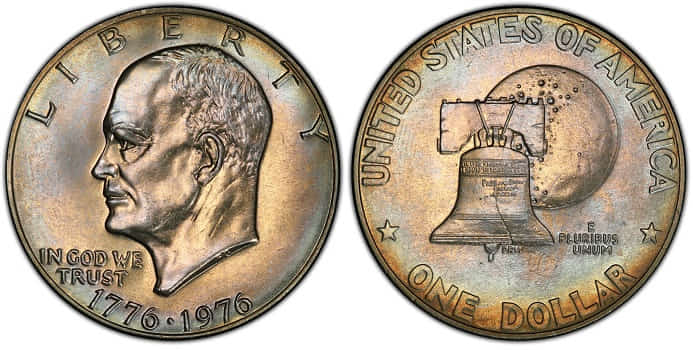
JUMP TO SECTION
Related: 1976 Bicentennial Kennedy Half Dollar value. We have already published an article that give you all kind of information about the composition of the Clad and Silver versions of the 1776-1976 Eisenhower “Ike” Reverse Bicentennial Dollar.
The design of the 1976 Bicentennial Eisenhower Dollar is modified on the obverse, where the two dates are separated by a dot “1776 · 1976,” and on the reverse with the Liberty Bell and the Moon in the background.
The Bicentennial Silver Dollar was issued in both uncirculated and proof versions and was struck in a copper-nickel clad composition. Despite its name, the coin was not minted in silver. It was part of a broader celebration of the American bicentennial, which included various events, parades, and other commemorations.
How to identify a 1976 Bicentennial Ike Dollar?
The 1976 Bicentennial Eisenhower Dollars were minted at three U.S. mints: Philadelphia, Denver, and San Francisco. Philadelphia and Denver exclusively minted the 1976 Bicentennial Eisenhower Reverse Dollars in Clad Regular Strike, which means they were intended for circulation among the general population.
Both mints produced the Type I and Type II versions of the 1976 Bicentennial Eisenhower Dollar. What is the difference between the two types?
- Type I: has thicker lettering in the legends on the edge of the reverse
- Type II: the lettering in the legends became thinner to match the size of the legend on the obverse.
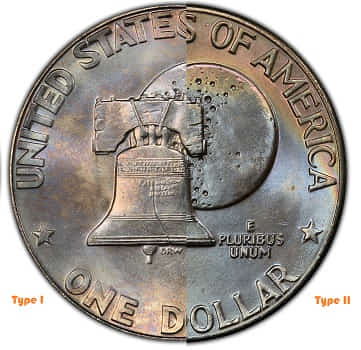
At the Philadelphia Mint, a total of 4,019,000 units of the Type I Bicentennial Eisenhower Dollar were minted, while 113,318,000 units of the Type II were produced. Therefore, it is logical that the Type I Bicentennial Eisenhower Dollars from Philadelphia are rarer than the Type II version. In fact, according to PCGS grading, the highest grade achieved for the Type I Bicentennial Eisenhower Dollar is MS66+ (with only one known specimen), while the Type II reaches MS67 (with a census of 15 specimens).
A similar pattern occurred at the Denver Mint, where fewer Type I coins were minted, although not in such a scarce proportion. The data shows that 21,048,710 units of the Type I Bicentennial Eisenhower Dollar were produced in Denver, compared to 82,179,564 units of the Type II.
Only the San Francisco Mint minted the 1976 Bicentennial Dollar in its Proof version, as well as in silver. For the silver coins, 11,000,000 units were minted in Regular Strike and 4,000,000 units in Proof.
What is a 1976 bicentennial silver dollar worth?
The value of a 1976 United States Bicentennial silver coin can vary depending on its condition and specific characteristics. These coins were minted in 0.400 troy ounces of silver (approximately 11.34 grams) and bear the commemorative design of the Bicentennial of American Independence.
In general, the value of a circulated 1976 Bicentennial silver coin is primarily determined by its silver content. With a weight of 0.400 troy ounces of silver, its value is based on the current price of silver in the market. It’s important to note that the price of silver fluctuates constantly, so it’s necessary to check for updated silver prices.
In addition to the intrinsic value of the silver, Bicentennial coins can also have additional numismatic value if they are in high-quality condition or have special characteristics, such as being in Proof condition or having a high conservation grade.
Here is a list of some valuable 1976 Bicentennial coins:
1. 1976-S Silver Bicentennial Ike Dollar – MS69 NGC – $20,800
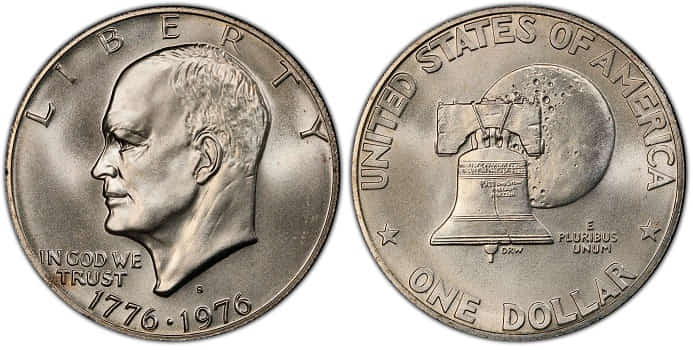
We have information that a 1976-S Silver Bicentennial Reverse Dollar in MS69 NGC grade was sold on eBay for $20,800 last March of this year, 2023. The MS69 grade is the highest rating for a 1976-S Silver Bicentennial Ike Dollar, both in PCGS and NGC.
It’s important to note that PCGS has only one specimen with this rating, while NGC has two specimens, with one of them achieving the previously mentioned record sale. This information is significant because the second 1976-S Silver Bicentennial Ike Dollar, graded as MS69 by NGC, was sold at Heritage in 2019 for $4,560. Until that point, it was the only specimen rated as MS69 by NGC, and there were none in that rating in PCGS. You can find more information just here.
In a lower grade, MS68+, a 1976-S Silver Bicentennial Reverse Dollar from PCGS CAC was auctioned at Stacks Bowers, also in March of this year, for $4,320 (reference).
2. 1976-D Clad Bicentennial Ike Dollar Type I – MS67 PCGS – $9,600
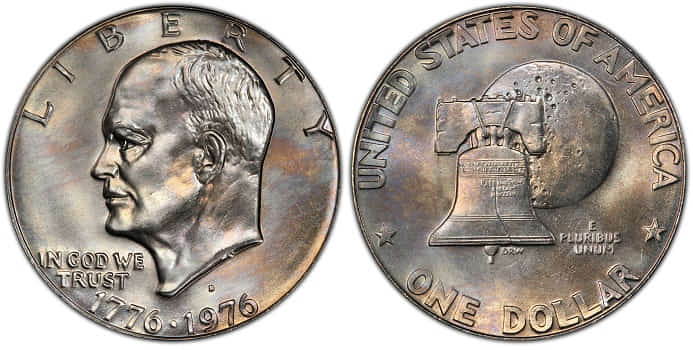
There is only one example of the 1976-D Bicentennial Reverse Eisenhower Dollar Type I that has been graded as MS67+ by PCGS, and there are 17 examples graded as MS67. Among these 17 MS67 examples, one in particular was auctioned in 2020 for $9,600 at a Stacks Bowers auction (reference).
This price is quite similar to the one recorded in 2016 for another MS67 example of the 1976-D Clad Bicentennial Ike Dollar Type I at a Heritage auction, which sold for $8,813. Currently, there is a 1976-D Clad Bicentennial Reverse Dollar MS67 PCGS for sale at $11,000 € on the following link.
3. 1976 Clad Bicentennial Ike Dollar Type I – MS66 PCGS.CAC – $5,640

The only example of the 1976 Clad Bicentennial Eisenhower Dollar, graded as MS66+ by PCGS, the highest grade for this denomination and type according to PCGS, was sold in 2017 for $5,640 at a Heritage auction. While it is true that the highest auction record is held by an MS66 example of the 1976 Bicentennial Ike Dollar, auctioned by Heritage in 2014 and sold for $7,638, we cannot consider that price as a reference due to its occurrence almost 10 years ago. In fact, in 2019, an MS66 CAC graded by PCGS of the 1976 Bicentennial Eisenhower Dollar was auctioned for $3,360, which is half of the record reached in 2014 (reference).
4. 1976-D Clad Bicentennial Ike Dollar Type II – MS67 NGC – $3,600
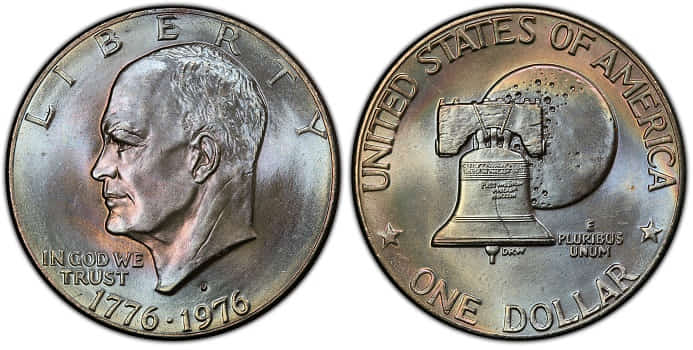
In March 2021, a 1976-D Clad Bicentennial Reverse Dollar MS67 graded by NGC, from the Pittstown Collection, was auctioned at Stacks Bowers for $3,600. Although we are aware that there are specimens of the 1976-D Clad Bicentennial Eisenhower Dollar in a higher grade, MS67+, we do not have auction records to compare them. However, we can inform you that an ongoing auction for a 1976-D Clad Bicentennial Reverse Dollar Type II MS67 by NGC will soon conclude at Great Collections auction house.
5. 1976-S Clad Bicentennial Ike Dollar Type II – PR70 DCAM PCGS – $3,000
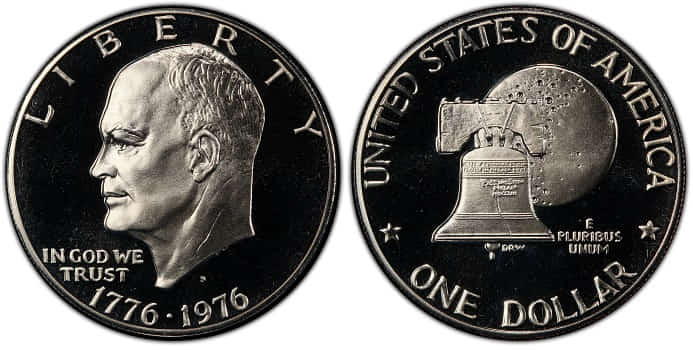
Among all the specimens of the 1976-S Clad Bicentennial Reverse Dollar Proof, the Type II DCAM (Deep Cameo) is one of the two with the highest recorded price. Specifically, a PCGS graded Type II PR70 DCAM specimen was auctioned at Heritage for $3,000 in 2023.
In 2022, other specimens, also in the same PR70 DCAM grade and PCGS graded, were auctioned at Heritage between $3,120 and $3,360, representing slightly higher prices but not significantly different from the more recent 2023 specimen. In 2021, a 1976-S Clad Bicentennial Reverse Dollar Type II PR70 DCAM was sold for $4,320 at Heritage.
In other words, there has been a slight decline in prices for the 1976-S Clad Bicentennial Eisenhower Dollar PR70 DCAM in the past three years, as evidenced by the auction results. However, it is worth noting that this decline is small. The prices obtained are far from the $22,550 achieved by one of these specimens with the “Gold Label” designation in an auction at Great Collections in 2014 (reference).
6. 1976-S Clad Bicentennial Ike Dollar Type II David Hall Signature – PR70 DCAM PCGS – $2,280

The case of the 1976-S Clad Bicentennial Reverse Dollar Type II PR70 DCAM with the David Hall signature (see photo for more details) is quite intriguing, as the auction record until this year, 2023, stood at $3,150 for a specimen sold on eBay in 2018. There are only 6 specimens graded as PR70 by PCGS. Well, in January 2023, during a Heritage auction, a PR70 DCAM specimen was sold for $2,280, representing a 30% price drop in less than 5 years.
What’s intriguing is that in May of the same year, 2023, the same specimen that was auctioned in January at Heritage was once again put up for auction, but this time it reached a price of $1,860, signifying an 18% decline in just 4 months (reference).
7. 1976-S Silver Bicentennial Ike Dollar David Hall Signature – PR70 DCAM PCGS – $2,170
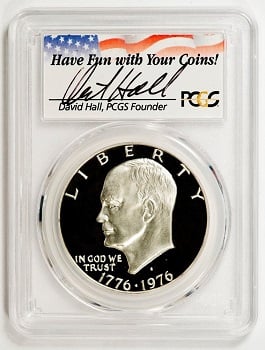
The specimen featured in the photo, signed by David Hall, co-founder of PCGS, was sold on eBay for $2,170 in the year 2020. It is a PR70 DCAM specimen. Observing the current market, we can conclude that the silver version of the 1976-S Bicentennial Eisenhower Dollar signed by Mr. David Hall has a contrasting trend to its nickel clad Type II counterpart (or simply Clad, as referred to in this article).
While the 1976-S Bicentennial Ike Dollar Type II David Hall in PR70 DCAM has dropped nearly in half in 2023 compared to the auction record set in 2018, the 1976-S Bicentennial Reverse Ike Dollar Silver PR70 DCAM is currently being auctioned at Great Collections (with 2 specimens), approaching the previous sales price record set in 2020. We will leave the links here, as we assume that, at the time of publication of this text, the auctions will have concluded, and you can verify whether the final auction price exceeded the $2,170 from 2020 (references 1 and 2).
8. 1976 Clad Bicentennial Ike Dollar Type II – MS67 PCGS – $1,800
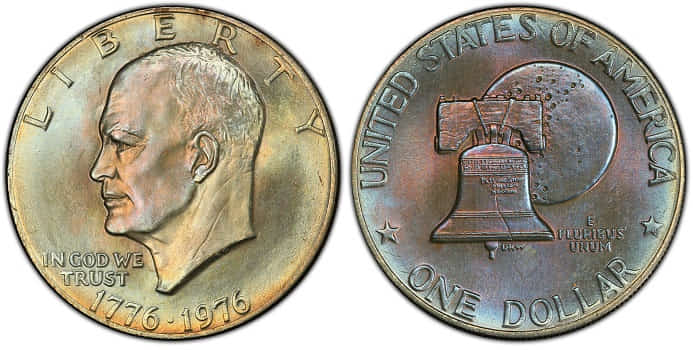
The Type II of the 1976 Clad Bicentennial Eisenhower Dollar is more common than the Type I, allowing for gradings up to MS67 in PCGS, with 15 pieces recorded at this highest grade. In 2018, an MS67 PCGS specimen of the 1976 Clad Bicentennial Eisenhower Dollar Type II from the former Rosie Collection was sold for $1,800 in a Stacks Bowers auction.
However, it is noteworthy that similar specimens were sold at Heritage auctions in 2017 for prices ranging from $2,235 to $2,585, and earlier in 2016 for $2,938.
As can be observed, the price of the 1976 Clad Bicentennial Reverse Ike Dollar MS67 has been decreasing in recent years. It would be necessary to analyze how their prices have evolved since the Covid-19 pandemic in 2020. However, we do not have enough objective data to assert a trend.
References and sources
- Heritage Auctions, “What’s My Coin Worth?, https://coins.ha.com/ref/price-guide.zx”
- NGC Coins, “NGC Price Guide, https://www.ngccoin.com/price-guide/united-states/”
- The Official Red book 2025, “A Guide Book of United States Coins, https://g.co/kgs/8TcE3yq”
- Wikipedia, «List of most expensive coins, https://en.wikipedia.org/wiki/List_of_most_expensive_coins»
- Yahoo Finance, «9 Rare American Coins That Are Worth a Lot of Money, https://finance.yahoo.com/news/9-rare-american-coins-worth-120155095.html»

